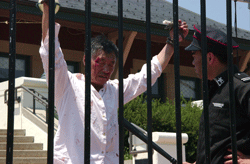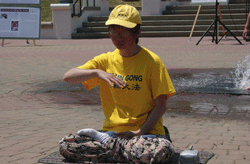Yuri Victor/Summer Editor

The Falun Gong exhibition on Friday and Saturday raised awareness of practitioners' persecution by the Chinese government.

An Asian man lay strapped onto a table, his forehead gleaming with sweat from the midday sun and a dried, red substance splattered on his white clothing. A wound was painted on his temple. He was still except for the slight rise and fall of his chest with each breath, stoic, transformed into a temporary, living monument to the persecution of the Falun Gong in China.
He was silent, like the rest of the actors, like the rest of Riehle Plaza on Friday and Saturday, for the demonstration of the Falun Gong's persecution. Indiana Falun Gong practitioners presented the exhibition.
The title for the display was "Persecution Meets Principle," and organizers such as Dana Cheng described to visitors how Falun Gong, or Falun Dafa, is about the virtues of truth, compassion and forbearance, along with exercises and meditation so that the practice sculpts body and mind.
It is practiced in 60 countries and has been practiced by over 100 million people.
Cheng and others would then discuss how the Chinese government is persecuting followers.
Organizers made a circle along the rim of the plaza with boards of information about the persecution and their beliefs, and actors, like the man strapped to the table, physically demonstrated documented Chinese methods of torture for practitioners.
Cheng pointed to the man on the table and said one of her friends was tied down like that for five months. Large print boards nearby display other kinds of torture: old-fashioned methods using heat, cold and food and sleep deprivation, while others had a distinctly Asian flair, like sharpened bamboo shoots stuck through fingernails. On one large piece of poster board, there was a drawing of a man being held upside-down on a wooden device that looked as if it were somewhere between a table on its side and a cross.
Another of my friends, said Cheng, was tied to a cross like that and hung upside-down for three days.
"Nine of my friends are in jail," she added.
Since the persecution began more than five years ago in China, at the direction of then-President Jiang Zemin, more than 950 Falun Gong followers have been killed for their beliefs. Countless more have been put into labor camps, mental hospitals or were tortured until they renounced their beliefs.
As visitors walked through the plaza, brought by curiosity or by simply being in the area, they received pamphlets and heard first-hand knowledge about the practice, about the persecution.
Organizers used terms such as "human rights violations" and "civil disobedience." They talked of lawsuits and promoting awareness.
"I can't believe other people do this to other people for what they believe," said Anne Bosse, a Lafayette resident who had met with friends nearby and stopped to see what the exhibition was about. She stared at the posters as she spoke.
Bosse said that as an U.S. citizen, she has never had to worry about being oppressed for believing in something. She reiterated her quiet disbelief one more time before moving on.
As Bosse and other visitors circled the ring of displays around the plaza, there was much to see, unsettling as it was for some.
But the graphic depictions were not the primary source of such discomfort. Instead, it was the constant reminder that the vivid displays were merely token samplings of what is happening on the other side of the world.
In between the boards of information, an actress sat in a cage that would be uncomfortably small for a medium-sized dog, her hands cuffed to the top of the cage, her face almost in tears, her body silent, still. A man next to her was in a taller cage but the inside of the cage was filled with nails, so he could not lean against anything for support, for rest. His hands were also cuffed to the top. His face was sullen and shiny with sweat and his hair was ruffled. Another scene depicted a man tied to a chair in a mental hospital.
Most of the actors were splattered in fake blood.
All looked miserable.
And in the middle of it all, physically and metaphorically, sat a small woman in a yellow Falun Gong T-shirt and hat, serenely meditating.
Category: Falun Dafa in the Media





